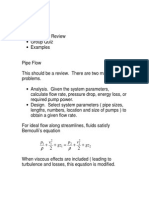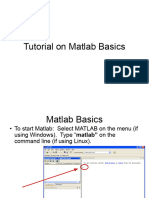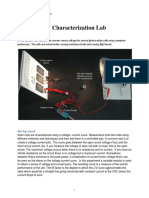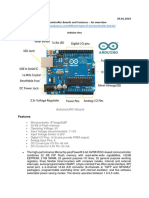The D Operator - Differential - Calculus - Maths Reference With Worked Examples
Uploaded by
Joseph QuarcooThe D Operator - Differential - Calculus - Maths Reference With Worked Examples
Uploaded by
Joseph QuarcooMaths Calculus Differential
The D operator
Solving Differential Equations using the D operator
Theory Of Differential Operator (differential Module)
Contents
1. Theory Of Differential
Operator (differential Module)
Definition
2. The D Operator And The
A differential operator is an operator defined as a function of the differentiation operator.
It is helpful, as a matter of notation first, to consider differentiation as an abstract operation, accepting a function and
returning another (in the style of a higher-order function in computer science).
The most commonly used differential operator is the action of taking the derivative itself. Common notations for this
operator include:
Fundamental Laws Of
Algebra
3. The Use Of The D Operator
To Find The Complementary
Function For Linear
Equations
4. Three Useful Formulae
and if generalize
Based On The Operator D
Note
is an operator and must therefore always be followed by some expression on which it operates.
5. Linear First Order D
Equations With Constant
Coefficients
6. Linear Second Order D
Simple Equivalents
Equations With Constant
means
Coefficients
but
7. Physical Examples
8. Page Comments
Similarly
and
The D Operator And The Fundamental Laws Of Algebra
The following differential equation:
may be expressed as:
or
This can be factorised to give:
But is it justifiable to treat D in this way?
Algebraic procedures depend upon three laws.
The Distributive Law:
The Commutative Law:
The Index Law:
If D satisfies these Laws, then it can be used as an Algebraic operator(or a linear operator). However:
only when u is a constant.
Thus we can see that D does satisfy the Laws of Algebra very nearly except that it is not interchangeable with variables.
In the following analysis we will write
are constants and
is a positive integer. As has been seen, we can factorise this or perform any operation depending
Examples
upon the fundamental laws of Algebra.
We can now apply this principle to a number of applications.
The Use Of The D Operator To Find The Complementary Function For
Linear Equations
It is required to solve the following equations:
Example - Simple example
Example:
Example:
Problem
Solve the following equation:-
Workings
Using the D operator this can be written as:-
Solution
Integrating using
as the factor
Three Useful Formulae Based On The Operator D
Equation A
Let
represent a polynomial function
Since
and
From which it can be seen that:
Example - Equation A example
Problem
Workings
This can be re-written as:
Solution
We can put D = 4
Equation B
Where
is any function of x
Applying Leibniz's theorem for the
Similarly
differential coefficient of a product.
and so on
therefore
Example - Equation B example
Problem
Find the Particular Integral of:
Workings
We have used D as if it were an algebraic constant but it is in fact an operator where
Solution
Equation C - Trigonometrical Functions
Example:
And so on
Therefore
similarly
Example - Trigonometric example
Example:
Problem
Find the Particular Integral of:-
Workings
This can be re-written as:-
(1)
Using equation 1 we can put
If we multiply the top and bottom of this equation by
But
Solution
But since
Linear First Order D Equations With Constant Coefficients
These equations have
on the right hand side
This equation is
Using an Integrating Factor of
the equation becomes:-
Which is the General Solution.
Linear Second Order D Equations With Constant Coefficients
Where
are the roots of the quadratic equation. i.e. the auxiliary equation.
Where
is an arbitrary Constant
This equation can be re-written as:-
Integrating
Thus when
we can write the General Solution as:-
Where A and B are arbitrary Constants.
Example - Linear second order example
Problem
Workings
The roots of this equation are:-
Therefore the General Solution is
Example:
The Special Case where
From Equation (41)
or
The roots of the Auxiliary Equation are complex.
If the roots of the are complex then the General Solution will be of the form
, and the solution will be given by:-
Solution
The roots of this equation are :-
Physical Examples
Example - Small oscilations
Example:
Problem
5
Show that if
satisfies the differential equation
with k < n and if when
The complete period of small oscillations of a simple pendulum is 2 secs. and the angular retardation due to air resistance is
0.04 X the angular velocity of the pendulum. The bob is held at rest so the the string makes a small angle
with the
downwards vertical and then let go. Show that after 10 complete oscillations the string will make an angle of about 40' with
the vertical.(LU)
Workings
Using the "D" operator we can write
When t = 0
= 0 and
=0
and
Solution
At t = 0
We have been given that k = 0.02 and the time for ten oscillations is 20 secs.
Last Modified: 30 Jul 12 @ 13:02
Page Rendered: 2014-02-10 16:33:38
You might also like
- Final Report Intern - Nur Maizatul AdhaNo ratings yetFinal Report Intern - Nur Maizatul Adha117 pages
- Hydraulics Lecture-Notes Open-Channel-Flow Dulal 20% (1)Hydraulics Lecture-Notes Open-Channel-Flow Dulal 214 pages
- Proposed Mechatronics and Biomedical Engineering With Minor Corrections100% (1)Proposed Mechatronics and Biomedical Engineering With Minor Corrections138 pages
- Transmission Lines: Steady-State OperationNo ratings yetTransmission Lines: Steady-State Operation30 pages
- Engineering Economy Solution Manual PooNo ratings yetEngineering Economy Solution Manual Poo301 pages
- Applied Engineering Economics: Dr. Scott J. Amos, PENo ratings yetApplied Engineering Economics: Dr. Scott J. Amos, PE1 page
- EEE3283 Electrical Machines and Drives Assignment Dec2022No ratings yetEEE3283 Electrical Machines and Drives Assignment Dec20226 pages
- Cs-101: Computer Systems: Introduction To Programming Using MatlabNo ratings yetCs-101: Computer Systems: Introduction To Programming Using Matlab60 pages
- TEAM 7 - Mechanical Engineering Final Year ProjectNo ratings yetTEAM 7 - Mechanical Engineering Final Year Project79 pages
- MEMO - FIC1502 - 2021 - Assignment 01 Final PDFNo ratings yetMEMO - FIC1502 - 2021 - Assignment 01 Final PDF13 pages
- KTU Thermal Science Mtech Draft SyllabusNo ratings yetKTU Thermal Science Mtech Draft Syllabus82 pages
- 1 of Chapter 3 Random Variables and Discrete Probability DistributionsNo ratings yet1 of Chapter 3 Random Variables and Discrete Probability Distributions16 pages
- 06 - Writing Common Engineering Documents-B (Ch5)No ratings yet06 - Writing Common Engineering Documents-B (Ch5)24 pages
- Modelling and Simulation of Car Radiator Effects of Fins100% (1)Modelling and Simulation of Car Radiator Effects of Fins17 pages
- Eed3001 Lab2 Single Phase Transformer Loading EM3000No ratings yetEed3001 Lab2 Single Phase Transformer Loading EM30005 pages
- ME 467: Automobile Engineering 3:00 Credit HoursNo ratings yetME 467: Automobile Engineering 3:00 Credit Hours3 pages
- Outline: MEEG 512X: Computational Fluid Dynamics Lecture 1: IntroductionNo ratings yetOutline: MEEG 512X: Computational Fluid Dynamics Lecture 1: Introduction10 pages
- 0-KNS4442 Integrated Design Project 1 - CP-EE - 220217No ratings yet0-KNS4442 Integrated Design Project 1 - CP-EE - 2202174 pages
- Manual For Experiential Learning Using Matlab: RV College of EngineeringNo ratings yetManual For Experiential Learning Using Matlab: RV College of Engineering44 pages
- BA101 ENGINEERING MATHEMATIC Chapter 1 Basic AlgebraNo ratings yetBA101 ENGINEERING MATHEMATIC Chapter 1 Basic Algebra37 pages
- 2019-Me-111 Lab Report 2 (Quick Return Mechanism)No ratings yet2019-Me-111 Lab Report 2 (Quick Return Mechanism)8 pages
- Explain The Purpose of Technical ProposalsNo ratings yetExplain The Purpose of Technical Proposals9 pages
- CE-2101 Fluid Mechanics: Flow Through Orifices & Notches100% (1)CE-2101 Fluid Mechanics: Flow Through Orifices & Notches45 pages
- Module 4. Antiderivatives and Integrals - 0NANo ratings yetModule 4. Antiderivatives and Integrals - 0NA54 pages
- Solving ODEs by Complementary Function and Particular Integral100% (1)Solving ODEs by Complementary Function and Particular Integral3 pages
- L.: (X) :2x2+3,:3x-5,: Total Printed Pages. 1c-202l$lqrhs-Ill2ndNo ratings yetL.: (X) :2x2+3,:3x-5,: Total Printed Pages. 1c-202l$lqrhs-Ill2nd6 pages
- God Is A Mathematician and He Doesn't Play Dice.: Francis CollinsNo ratings yetGod Is A Mathematician and He Doesn't Play Dice.: Francis Collins2 pages
- Organic Chemistry Assignment-1: Complex Question SETNo ratings yetOrganic Chemistry Assignment-1: Complex Question SET6 pages
- (David Matsumoto) The Handbook of Culture and Psyc (B-Ok - Xyz) PDF100% (1)(David Matsumoto) The Handbook of Culture and Psyc (B-Ok - Xyz) PDF475 pages
- EMV of ALTERNATIVES - Final RequirementNo ratings yetEMV of ALTERNATIVES - Final Requirement28 pages
- Chapter 6 Functions: For Educational Purpose Only. Not To Be Circulated Without This BannerNo ratings yetChapter 6 Functions: For Educational Purpose Only. Not To Be Circulated Without This Banner132 pages
- Holt Algebra 2 Homework and Practice Workbook Answers100% (1)Holt Algebra 2 Homework and Practice Workbook Answers4 pages
- L9 Microcontroller Boards&Features OverviewNo ratings yetL9 Microcontroller Boards&Features Overview8 pages
- Microprocessor_Lab_Manual Final for PrintNo ratings yetMicroprocessor_Lab_Manual Final for Print19 pages
- Oil & Gas Industry Interview Questions Answers100% (1)Oil & Gas Industry Interview Questions Answers13 pages
- Year 10 Baseline Test Maths Foundation Non-Calculator (Interactive)No ratings yetYear 10 Baseline Test Maths Foundation Non-Calculator (Interactive)8 pages
- Colligative Properties - Liquid SolutionsNo ratings yetColligative Properties - Liquid Solutions2 pages
- Hydraulics Lecture-Notes Open-Channel-Flow Dulal 2Hydraulics Lecture-Notes Open-Channel-Flow Dulal 2
- Proposed Mechatronics and Biomedical Engineering With Minor CorrectionsProposed Mechatronics and Biomedical Engineering With Minor Corrections
- Applied Engineering Economics: Dr. Scott J. Amos, PEApplied Engineering Economics: Dr. Scott J. Amos, PE
- EEE3283 Electrical Machines and Drives Assignment Dec2022EEE3283 Electrical Machines and Drives Assignment Dec2022
- Cs-101: Computer Systems: Introduction To Programming Using MatlabCs-101: Computer Systems: Introduction To Programming Using Matlab
- TEAM 7 - Mechanical Engineering Final Year ProjectTEAM 7 - Mechanical Engineering Final Year Project
- 1 of Chapter 3 Random Variables and Discrete Probability Distributions1 of Chapter 3 Random Variables and Discrete Probability Distributions
- Modelling and Simulation of Car Radiator Effects of FinsModelling and Simulation of Car Radiator Effects of Fins
- Eed3001 Lab2 Single Phase Transformer Loading EM3000Eed3001 Lab2 Single Phase Transformer Loading EM3000
- Outline: MEEG 512X: Computational Fluid Dynamics Lecture 1: IntroductionOutline: MEEG 512X: Computational Fluid Dynamics Lecture 1: Introduction
- 0-KNS4442 Integrated Design Project 1 - CP-EE - 2202170-KNS4442 Integrated Design Project 1 - CP-EE - 220217
- Manual For Experiential Learning Using Matlab: RV College of EngineeringManual For Experiential Learning Using Matlab: RV College of Engineering
- BA101 ENGINEERING MATHEMATIC Chapter 1 Basic AlgebraBA101 ENGINEERING MATHEMATIC Chapter 1 Basic Algebra
- CE-2101 Fluid Mechanics: Flow Through Orifices & NotchesCE-2101 Fluid Mechanics: Flow Through Orifices & Notches
- Computer Aided Design of Electrical MachinesFrom EverandComputer Aided Design of Electrical Machines
- Solving ODEs by Complementary Function and Particular IntegralSolving ODEs by Complementary Function and Particular Integral
- L.: (X) :2x2+3,:3x-5,: Total Printed Pages. 1c-202l$lqrhs-Ill2ndL.: (X) :2x2+3,:3x-5,: Total Printed Pages. 1c-202l$lqrhs-Ill2nd
- God Is A Mathematician and He Doesn't Play Dice.: Francis CollinsGod Is A Mathematician and He Doesn't Play Dice.: Francis Collins
- Organic Chemistry Assignment-1: Complex Question SETOrganic Chemistry Assignment-1: Complex Question SET
- (David Matsumoto) The Handbook of Culture and Psyc (B-Ok - Xyz) PDF(David Matsumoto) The Handbook of Culture and Psyc (B-Ok - Xyz) PDF
- Chapter 6 Functions: For Educational Purpose Only. Not To Be Circulated Without This BannerChapter 6 Functions: For Educational Purpose Only. Not To Be Circulated Without This Banner
- Holt Algebra 2 Homework and Practice Workbook AnswersHolt Algebra 2 Homework and Practice Workbook Answers
- Year 10 Baseline Test Maths Foundation Non-Calculator (Interactive)Year 10 Baseline Test Maths Foundation Non-Calculator (Interactive)


































































































